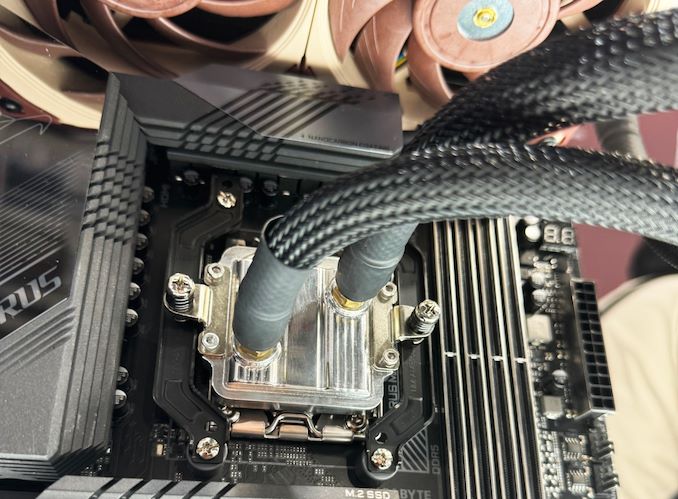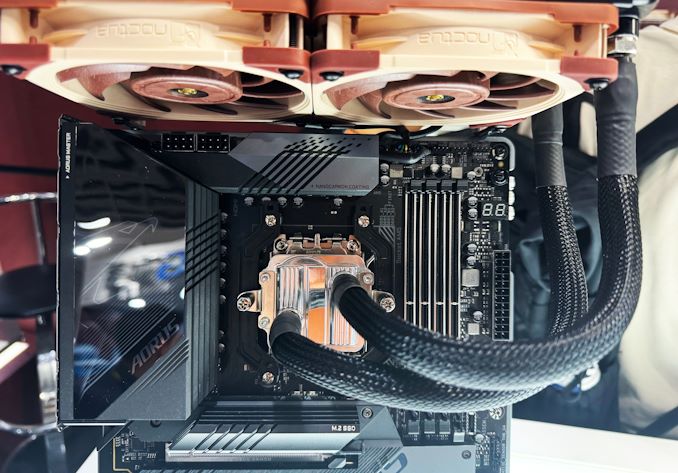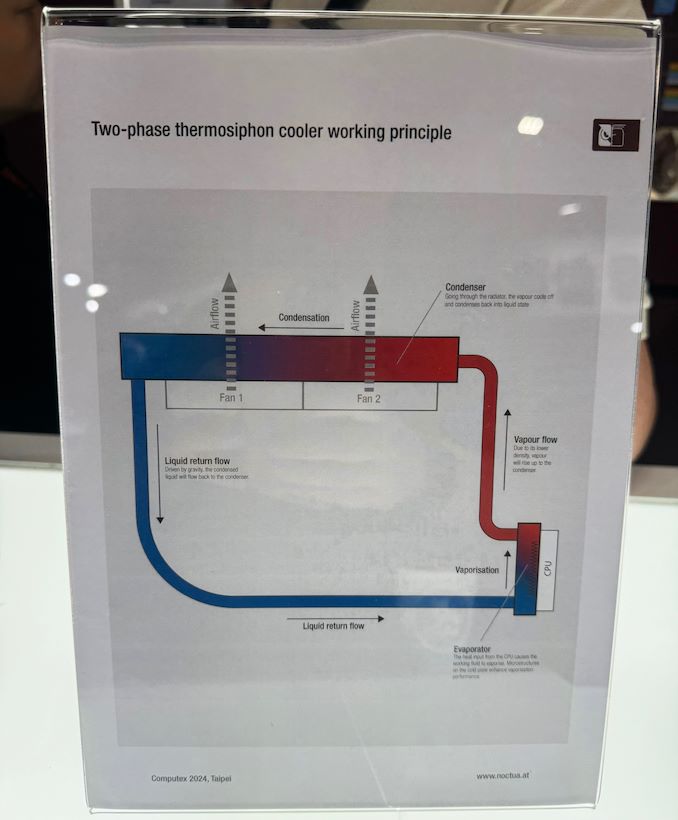Noctua Shows Off Thermosiphon Based CPU Cooler Prototype At Computex 2024
by Gavin Bonshor on June 13, 2024 10:30 AM EST
Many companies showed off a range of concept designs during Computex 2024, but perhaps Noctua had one of the coolest. Noctua, primarily known for its air coolers, had a pumpless prototype that showcased Thermisiphon cooling. It looks like a conventional AIO cooler on the surface but is much more efficient, cooler, and quieter than traditional water coolers.
Touching quickly on Thermosiphon cooling, it uses the natural laws of thermodynamics to use heat (the CPU) as a source to turn the liquid to the top, evaporating through the system. This evaporated liquid rises and is pushed into the condenser (radiator), which, in the case of Noctua's cooler, is cooled by fans and turned back into liquid, which then flows back toward the CPU. Not only does Theromsiphon technology use gravity to help aid the flow of liquid, but it is also a highly efficient way of distributing heat as vaporization can absorb heat better, and it doesn't feature any moving parts in the mechanism, aside from the fans, of course.
As with traditional AIO CPU coolers, Noctua's Thermosiphon design has a 240mm radiator with a pair of 120cm Noctua fans, which cools the vapor down and sends it back to the evaporator. While this isn't a new concept and vapor chamber cooling has been used for many years in CPUs and even laptop coolers, Thermosiphon is certainly a technology Noctua thinks it can leverage to ensure better cooling performance and robust reliability.
Speaking to Noctua at Computex 2024, they informed me of the benefits and pitfalls of the Thermosiphon technology. In terms of the pros, Thermosiphon cooling in itself has no moving parts, which not only improves reliability but also means there is less to go wrong. Another positive is that even the quietest AIO CPU coolers can be quite noisy, as the water pump that circulates the fluid can cause vibrations, which in turn makes noise. The biggest drawback of implementing Thermosiphon cooling for PCs is that conventional tubing can wear out over time. While adding metal tubing would last longer, it's not flexible, although Noctua said they have discussed this with system integrators.
Although Noctua's Thermosiphon is currently just a proof of concept and sis in the early development stage, there's no launch date or indication it will hit the market. It's an interesting design, and we hope it does eventually come to market.












4 Comments
View All Comments
meacupla - Thursday, June 13, 2024 - link
IMO, Noctua could make a killing if they designed a pump that doesn't vibrate as much or produce as much motor noise.Or, alternatively, whatever happened to their active noise-cancelling fan accessory?
Slap that between your PC and where you sit, and you don't have to worry about how loud your PC is.
edzieba - Thursday, June 13, 2024 - link
Companies have been showing off non-rigid heat-pipe coolers (thermosiphons are just heat-pipes with unidirectional flow) at trade shows for well over a decade, and thermosiphon cooling systems have been in use for many decades before then. The big problem is that for then to work with water as a working fluid (as in rigid copper heatpipes and vapour chambers) the flexible tubing needs to be gas impermeable - else the pressure inside will rise, the boiling point will rise, and the 'cold side' temperature will rise - which massively raises the cost of the cooler (and still degrades over time, just more slowly). Or the working fluid needs to be switched to one with a near-ambient boiling point (e.g. one of the Novecs), which also massively increases the cost of the cooler.ballsystemlord - Friday, June 14, 2024 - link
To solve that, you could just use a check valve at the top of the radiator. Gas comes in, gas goes out. Very simple.Alexvrb - Wednesday, June 26, 2024 - link
So, the problem is that you MUST achieve a sufficiently low boiling point (required for this system to actually cool the CPU to a tolerable temperature). Water boils at 100 degrees C at standard pressure (1 atmosphere), which means your CPU cores would probably be ABOVE 100 degrees to vaporize the water. So how do you reduce the boiling point? Well, there's option #2 edzieba already mentioned... use an expensive-as-hell fluid that has a far lower boiling point even at standard pressure.But the first option (which is the primary one being discussed)... is to reduce the boiling point of the water. To do this, the system must be BELOW atmospheric pressure. You fill the system partially with water, leaving some "empty" space (gas/air, there is math involved that is beyond me). Now, vacuum out the gas until you achieve the desired negative pressure, and seal the system up. Like vacuuming out an A/C system in preparation for recharging. This "sets" your boiling point to the desired temperature. The PROBLEM is if outside gas (higher pressure) permeates into the system (lower pressure), it raises the boiling point of the water and the whole system starts to degrade. A check valve cannot reduce the pressure below outside pressure (1 atmosphere)
Really good flexible tubing can work but it has a limited lifespan. Then again, so do CLWC pumps.